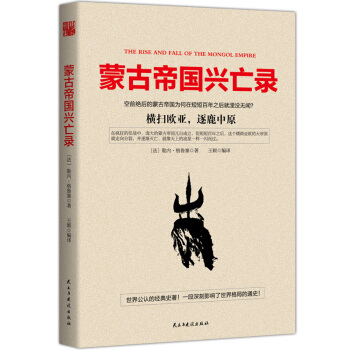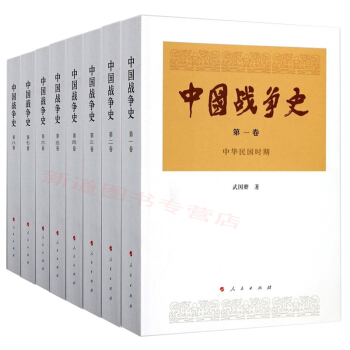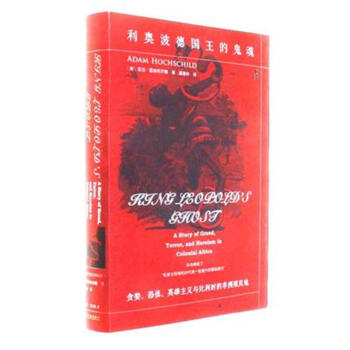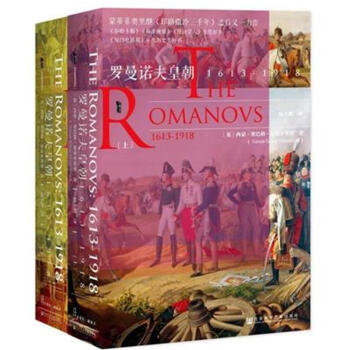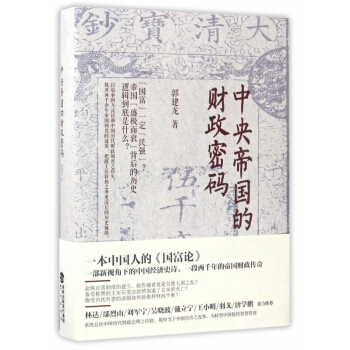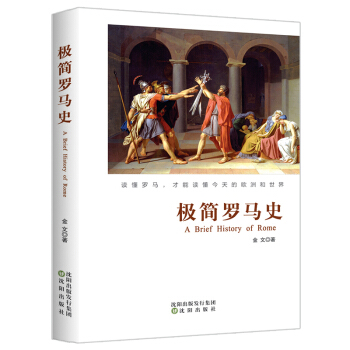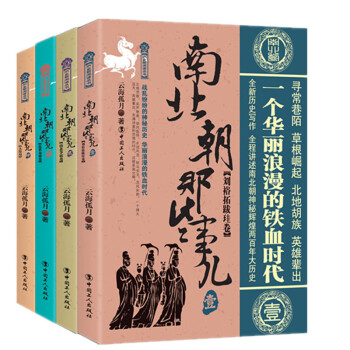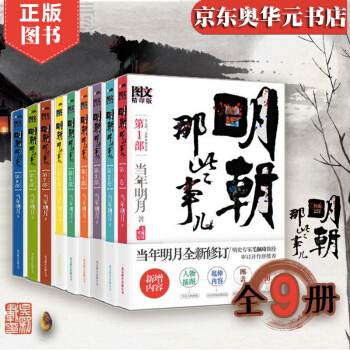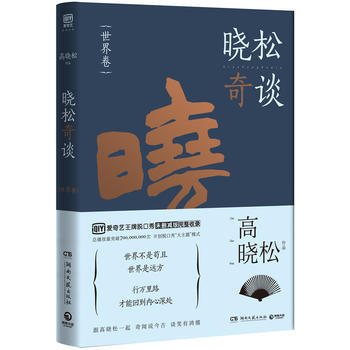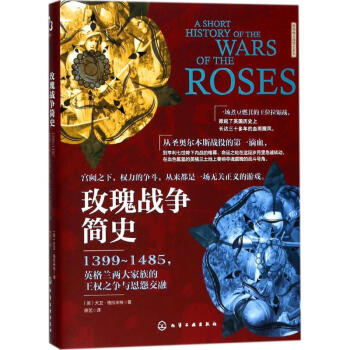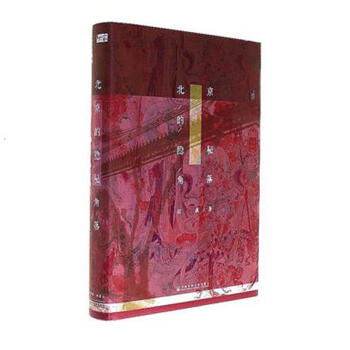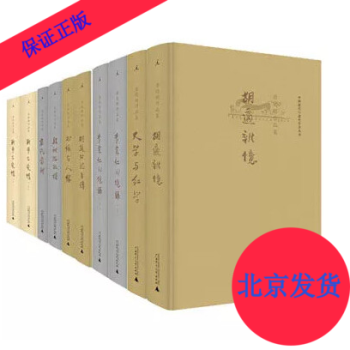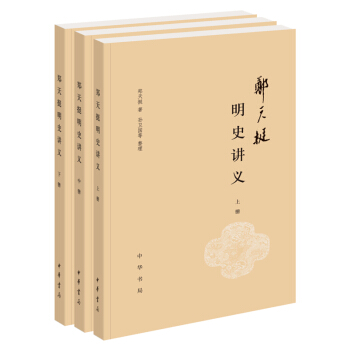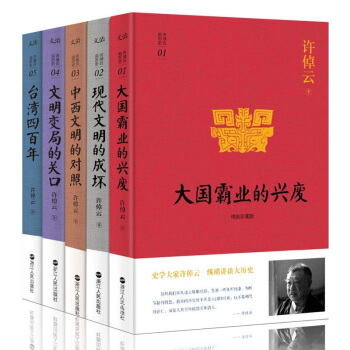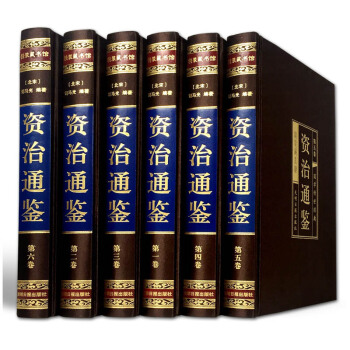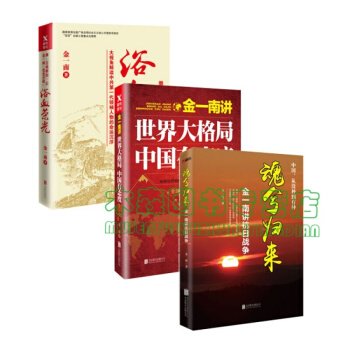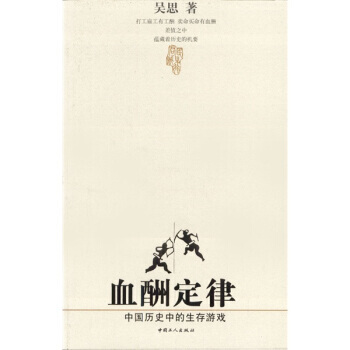

具体描述
编辑推荐
适读人群 :对中国历史感兴趣的外国读者和英语学习者☆中外学者合作介绍中国历史首部英文图书
☆历史年代为序,全面梳理中国历史
☆以中国视角叙述,兼顾外国读者阅读习惯
☆快速了解中国历史,面向外国读者普及读物
内容简介
《中国简史:从史前文明到末代皇帝》(HistoryofChina:FromEarliestTimestotheLastEmperor)是一部直接面向海外读者概览性地介绍中华民族五千年历史的图书。它是国内首部由国内外学者合作编著的介绍中国历史的图书,其内容在保持中国叙述视角的同时,兼顾国外读者的阅读习惯,是一本普及中国历史的读物。
本书以历史年代为序,再现了中华文明从远古文明到清朝结束的发展历程,全面回顾了自原始社会以来各个不同时期的中国历史画卷,涵盖了中国历史的主要内容,集中讲述了历史的变迁过程,较为系统地介绍了中国历史的发展脉络。是一部快速了解中国历史及社会变迁的图书。
作者简介
迈克尔·迪伦(Michael Dillon),杜伦大学当代中国研究中心创始人,于该校东亚系任教。主要研究领域为中国历史、政治和社会以及汉语。他拥有利兹大学中国研究的硕士和博士学位,是英国皇家历史学会和皇家亚洲学会的会员。他是《中国季刊》《民族和种族研究》《内亚》等刊物的特约评审专家,经常受邀做客BBC等国际广播公司评论中国及亚洲事务,是《泰晤士报文学增刊》的常驻作者,并担任由乔纳森·刘易斯为BBC2、Granada和PBS(美国)频道拍摄的一部中国主题的四集电视纪录片的顾问。他精通中文,能说普通话和一些广东话,并通晓新疆的维吾尔语。他出版的主要作品有《当代中国入门》(Routledge出版社,2008)、《现代中国史》(I.B.Tauris出版社,2010)。目前迪伦教授正在为Taylor & Francis出版社编辑《中国百科全书》一书。
内页插图
This is a Chinese account of China, seen from the inside and presenting many of the stories behind historical events that are familiar to Chinese people from their scooldays but are little known even among foreign historians of China. It is a valuable complement to the standard histories of China available in English.
——Michael Dillon
目录
Contents
ListofIllustrationsxii
NameandDateConventionsUsedintheContextxxxvii
Introductionxxxix
Chapter1
AncientCivilizations:RuleandPolitics
(c.8500–256BCE)
THEORIGINSOFCIVILIZATION–AncientManinChina–TheEraofClanSocieties–TheDawnoftheChineseNation–ThreeBenevolentRulers:Yao,ShunandYu–THEEARLIESTDYNASTIESOFCHINA–RuleoftheXiaDynasty–TheRiseandFalloftheShangDynasty–TheFlourishingoftheWesternZhouDynasty–DeclineoftheWesternZhouDynasty–THESPRINGANDAUTUMNPERIOD–DeclineoftheRoyalFamily–DukeHuanofQiandDukeWenofJin–ThreeSuccessiveHegemonies–WuandYuePushforPower–THESEVENPOWERSOFTHEWARRINGSTATESPERIOD–SevenPowersLockedinRivalry–ReformMovementsintheSevenStates–AllianceandUnification
Chapter2
AnEmergingState:SocietyandCulture
OracleBonesinShangLife–TheBronzeAge–TheDevelopmentofAgriculture–Crafts–TheDujiangyanWeirs–TheRiseoftheCity–Literature:BookofSongsandElegiesoftheSouth–Music:BellsandDrums–Astronomy–Medicine
Chapter3
TheFoundationsofPhilosophyandSchoolsofThought
THECONTENTIONOFAHUNDREDSCHOOLSOFTHOUGHT–Confucius:TeacherforAllAges–TheLegacyandDevelopmentofConfucianism–Daoism:LetThingsRunTheirCourse–TheMohistSchool:EarthlyAscetics–Legalism:FavoredbyRulers–MilitaryStrategists:MastersoftheLawofWar–THECLASHOFSCHOOLSOFTHOUGHT
Chapter4
UnificationundertheQinEmpire
(221–206BCE)
RULEOFTHEQINEMPIRE–QinShiHuang’sUnificationoftheCountry–CentralizationoftheQinEmpire–AReignofTyranny–THEWONDERSOFTHEQINDYNASTY–TheGreatWall–QinShiHuangMausoleum–TerracottaWarriorsandHorses–THEFALLOFTHEQINDYNASTY–ThePeasantUprising–ConflictbetweentheStatesofChuandHan
Chapter5
TheRiseandFalloftheHanDynasty
(220BCE–280CE)
THERISEOFTHEHAN–RebuildingbytheEarlyHanDynasty–EmperorsWenandJing–EmperorWuofHan–DECLINEOFTHEWESTERNHANDYNASTY–CorruptionintheMidandLateWesternHan–TheBriefReignofWangMang–REVIVALOFTHEHANCOURT–TheFoundingoftheEasternHanDynasty–PowerStruggles:CourtWomenandEunuchs–TheFalloftheEasternHanDynasty–FOREIGNRELATIONSDURINGTHEHANDYNASTY–MarriageBringsPeaceBeyondtheGreatWall–ZhangQian’sJourneystotheWesternRegions–TheSilkRoad
Chapter6
Scientific,CulturalandPhilosophicalDevelopmentsundertheHan
SCIENCEANDTECHNOLOGYOFTHEHANDYNASTY–TheInventionofPaper–TraditionalChineseMedicine–AstronomyandMathematics–THESTATUSOFIDEASINTHEHANDYNASTY–TheRiseofDaoism–TheSpreadofBuddhisminChina–EvolutionoftheScholarlyClass–CULTUREOFTHEHANDYNASTY–FirstMajorHistoricalWorks–LiteratureandArt
Chapter7
DisturbanceandStability:FromtheThreeKingdomstoaHundredYearsofJinRule
(220–420CE)
THETHREEKINGDOMS–TheBattleofGuandu–TheBattleofRedCliffs–EmergenceoftheThreeKingdoms–WESTERNANDEASTERNJIN–BriefUnificationduringtheJinDynasty–RebellionoftheEightPrinces–TheHundred-YearRuleoftheEasternJin
Chapter8
ThePoliticsandCultureoftheSouthernandNorthernDynasties
(420–589)
THESOUTHERNDYNASTIES–ContentionoftheSixteenKingdoms–RuleoftheSong,Qi,Liang,andChen–THENORTHERNWEIDYNASTY–RapidRiseoftheNorthernWeiDynasty–TheReformsofEmperorXiaowen–CrumblingoftheNorthernWei–TheCrushingofBuddhism–CULTURALDEVELOPMENTSDURINGTHESIXDYNASTIES–LiteratureandArt–TheStudyofHistoryandGeography–TheNaturalSciences–NEWPHILOSOPHICALEXPLORATIONS–DarkLearningandtheSevenSagesoftheBambooGrove–TheFlourishingofBuddhism–TheDevelopmentofDaoism
Chapter9
TheSuiDynasty
(581–618)
TheFoundingoftheSuiDynasty–TheRuleofEmperorWen–TheFalloftheSuiDynasty–TheGrandCanal
Chapter10
TheGoldenEraoftheTangDynasty
THEFOUNDINGANDGOVERNMENTOFTHETANGDYNASTY–TheRiseoftheTangFamily–TheGoldenYearsofZhenguan–TheUsurpingEmpress–TheGoldenEraofKaiyuan–THETANGEMPIRE–LIFEINTHETANGWORLD–Agriculture–TradeandCommerce–KeyInventions:WoodblockPrintingandGunpowder–Medicine–Astronomy–TANGCULTUREANDCRAFTS–Poetry–Novels–Calligraphy–Painting–MusicandDance–Crafts
Chapter11
Decline,SeparationandTurbulence:
TheDeclineoftheTangandRuleoftheSong
THEDECLINEOFTHETANGDYNASTY–TheAnLushanRebellion–EffortstoRevivetheTangEmpire–TurbulenceandDecline–ASplinteredAge:FiveDynasties,TenKingdoms–TheRiseoftheKhitan–THENORTHERNANDSOUTHERNSONGDYNASTIES–TheFoundingoftheNorthernSongDynasty–ReformandStrifeintheMidtoLateNorthernSong–TheCollapseoftheSouthernSongDynasty
Chapter12
Co-existingRegimes:TheSong,Liao,Xia,andJin
ConfrontationbetweenSongandLiao–TheRiseandFalloftheWesternXiaDynasty–TheRiseoftheJinEmpire–ConfrontationbetweenSouthernSongandJin
Chapter13
TheEnrichingLegacyoftheTangandSongDynasties
AThrivingEconomy–Science,Technology,andCulture
Chapter14
TerritorialExpansionandCulturalFlowerings:
TheYuanDynasty
(1206–1368)
THEFOUNDINGOFTHEYUAN–TerritorialExpansionoftheMongolEmpire–UnificationWar–TheYuanSystemofGovernment–YUANCULTUREANDECONOMY–TheCapital,Dadu–EthnicIntegration–TheEconomy–LiteratureandArtofSongandYuan
Chapter15
CentralizedMonarchyoftheMingDynasty
(1368–1644)
THEFOUNDINGOFTHEMING–TheFalloftheYuanDynasty–TheAbsoluteMonarchyoftheMingDynasty–TurmoilwithintheMingCourt–THEMINGDYNASTYECONOMYANDFOREIGNPOLICY–ThrivingEconomyandAdministrationofItsLand–Ming’sForeignPolicy–China’sRelationshipwithItsNeighbors–MerchantGuildsandBanking
Chapter16
Piracy,WarandRebellion:theDeclineoftheMingandRiseoftheQing
TURBULENCEANDDECLINEOFTHEMING–MingCostalDefense–EarlyColonialAggression–TheTumuCrisis–RevivalEortsinLateMing–ThreeNotoriousAairsofCourt–EunuchAbuseofPowerandtheDonglinMovement–ENDOFTHEMINGDYNASTY–WaningMilitaryPower–Rebellionofthe“DashingKing”–TheDoomedSouthernMingCourt–TheRiseoftheJurchens–Nurhaci:KhanofHeaven’sMandate–HongTaijiFoundstheQingEmpire
Chapter17
TheQing:Feudalism’sFinalBow
(1644–1911)
CONSOLIDATIONOFTHEQINGEMPIRE–Anti-QingResistance–ZhengChenggong’sRecoveryofTaiwan–SuppressionoftheThreeFeudatoriesbytheKangxiEmperor–TheRecoveryofTaiwan–BorderDefenseagainstTsaristRussia–SuppressionoftheDzungarRebellionandTorghutIntegration–SuppressionoftheUyghurRebellionandWarsagainstForeignIntruders–TheDalaiLamaandPanchenLama–THEFINALFLOWERINGOFCHINESEFEUDALSOCIETY–TheGrowingStrengthoftheMonarchyundertheQingDynasty–ProsperityoftheKangxi,Yongzheng,andQianlongReigns–TheRulingCrisisoftheMidtoLateQingDynasty
Chapter18
Learning,PhilosophicalThoughtandCultureundertheMingandQing
TECHNOLOGYANDTHOUGHTS–TheReconstructionofBeijing–Science,Technology,andtheIntroductionofWesternLearning–Neo-Confucianism–ANewStageinConfucianism–LITERATUREANDARTINTHEMINGDYNASTY–VernacularFiction–Mass-MarketNovels–MingOpera–CalligraphyandPainting–QINGCULTURE–ClassicalGardens–GovernmentCulturalProjects–ADreamofRedMansions–TheRisingPopularityofNovels–BreakthroughsinCalligraphyandPainting–BeijingOpera
Chapter19
WarsandRebellion:TheOpiumWars,BoxerRebellionandForeignPowers
THEOPIUMWARS–ChinaandtheWestbeforetheFirstOpiumWar–TheDestructionofOpiuminHumen–TheFirstOpiumWar–TheSecondOpiumWar–EmpressDowagerCixi’sRisetoPower–TheTaipingRebellion–TheEndoftheTaipingHeavenlyKingdom–WARINTHELATEQINGDYNASTY–ZuoZongtang’sRecoveryofXinjiang–TheSino-FrenchWar–TheSino-JapaneseWar–TheBoxerRebellionandtheAlliedForces’InvasionofChina
Chapter20
WesternInfluences,ReformandDeathoftheQing
TheChallengeofWesternCulture–TheSelf-StrengtheningMovement–TheRiseofCapitalism–IdeasofReform–TheHundredDays’Reform–TheQingCourt’sDyingThroes–TheRiseoftheRepublic–Conclusion
Index448
精彩书摘
《History of China 中国古代简史:从史前文明到末代皇帝》:So the Qing were defeated at the Battle of Gualar, the first battle between the Chinese and the Russians, but this marked the beginning of China's resistance to Russian mvasion; the quick response of the Qing government indicated the importance it attached to territorial integrity.
In 1653,internal conflict among the Russians led to Khabarov's dismissal and his return to Russia.Stepanov, his deputy, took over.To protect local residents, the Qing government moved them further inland and dis—patched troops; in 1658, Stepanov was killed and in 1659, the Qing army recaptured Yaksa.By 1660, the invading forces along the lower reaches of the Amur River had been wiped out.
However, the Russians did not give up easily.Taking advantage of the Qing preoccupation with the Three Feudatories, they invaded Heilong—jiang once again and regained many cities, including Yaksa.Defying the Qmg government's warnings, they continued their expansion, even demanding Qing's submission to the Russian tsar.So, when the Three Feudatories problem finally ended in 1681, the Kangxi Emperor immediately set out to reinforce northeastern China.ln the spring of1682, he made an inspection tour of cities such as Shengjing (today's Shenyang) and Wula (today's Jilin).Full preparations were made for a counterattack:courier stations, along with land and waterway systems, were all set up.
……
前言/序言
Introduction
The history of China is the story of the people who live between the coasts and the mountains and steppes of Inner Asia. Principally it is a history of settled agricultural communities, distinguished from and often in conflict with, the pastoral nomadic societies of the northern and western regions. The civilization that today we call Chinese originated in the north-central region of the mainland, around the Yellow River. It extends southwards to the Yangzi(or Yangtze), a formidable natural barrier, across which the state gradually asserted its authority. Ancient Chinese society emerged as a multiplicity of city states which were incorporated into the great empires of the Shang and Zhou. The authority of the Zhou Dynasty was exhausted in the fifth Century BCE and by then a network of independent statelets had emerged, in the era that became known as Spring and Autumn. Conflict between these statelets for dominance was reflected in the name for the following historical period — the Warring States. When one of these statelets, the Qin, grew in size and authority and emerged as the victor in 221 BCE, its leader declared himself Qin Shi Huang, the First Emperor of Qin, and is regarded as the first of the long series of emperors who ruled China until the disintegration of the empire in 1911.
This period set the pattern for the whole of the empire; the conflict between centralization and centrifugal political forces and between the settled and the pastoral lands. Since then, by and large, China has had powerful single rulers, emperors whose reign names mark successive periods of history. It would however be a mistake to assume that all of these emperors controlled the whole of the present-day territory of China or that they were Chinese in the commonly accepted modern sense. The great Tang Dynasty (618–907) was extraordinarily inclusive and open-minded and is admired for its poetry and sculpted ceramics. Tang emperors governed most of the country but their family backgrounds included the Turkic-speaking aristocracy.
The fate of the Song Dynasty (960–1279) illustrates well the conflict between the tribes of the steppe and the settled Chinese which marked the remainder of the empire. The Song (Northern Song) began as a successor to the Tang, controlling much of the same territory, but it was faced with serious military challenges on its frontiers and lost much of its northern territory to nomadic tribes, principally the Khitan Liao and the Tangut Xixia, whose regimes in the lands that they conquered are known by Chinese dynastic names. The Song emperors were forced to retreat south and their reign, the Southern Song—notable above all for its fine painting—lasted until the Mongols from the steppes, having defeated the other northern tribes including the Khitan and the Tanguts, finally conquered the whole of China and declared themselves to be the Yuan Dynasty (1271–1368). The emperors of the Yuan all had Chinese reign titles but their language and culture was Mongolian and they were part of the great Mongolian empire that spanned the whole of Asia during the thirteenth and fourteenth centuries. This regime was resented by many Chinese as an alien occupation—although many Chinese officials worked for it—and when the Mongols were driven back to the steppes in the middle of the fourteenth century, the Ming Dynasty that was established in Nanjing by Zhu Yuanzhang was welcomed as a return to Chinese rule.
The Ming lasted until 1644 when another northern people, the Manchus, produced a military apparatus that was able to overthrow the Chinese regime that had been weakened by corruption and internal power struggles. The Manchus took control of China, but, in order to rule it, had to cooperate with Chinese, Mongolian and Tibetan officials. Their dynasty, the Qing, was the last of the Chinese empire, although, ironically, it was not in the strict sense of the word a Chinese dynasty. As happened during the Yuan Dynasty, there was great opposition to Manchu control and a nationalist movement that emerged during the nineteenth century was strengthened by the inability of the government to resist commercial and military pressures from the maritime empires of Britain and the other Western powers. When the Manchu Qing regime was finally overthrown in 1911, the driving forces were the traditional ones of Chinese opposition to alien rule and the secession of provinces from the central government. However to this must be added a completely new element, the threat of Western encroachment which was to dominate the history of China in the early twentieth century.
History is not, of course, confined to the past. It continues as we live and it informs the thinking not only of historians and the readers of history but those in power. Chinese thinkers, writers and rulers are acutely conscious of the history of their country: it is constantly referred to in the contemporary political discourse of the country, although not everyone draws the same conclusions about the lessons to be learned from it. Nevertheless, without an appreciation of the multicultural and multiethnic historical background, with its conflicts and compromises and the successes and failures of its successive rulers, it is impossible to understand China as it rises to world prominence during the twenty-first century.
用户评价
作为一个对中国古代艺术和文化非常感兴趣的读者,我选择这本书,很大程度上是希望它能提供一个关于中国古代艺术发展脉络的视角。当然,标题是“简史”,我不敢奢求它能像艺术史专著那样详尽,但我希望它能在其中穿插一些关于艺术的重要介绍,让我能够对中国古代艺术有一个大致的了解。比如,从史前时期的彩陶艺术,到商周时期的青铜器纹饰,再到秦汉时期的雕塑和绘画,这些都是非常具有代表性的艺术形式。我希望这本书能够简单介绍它们的特点、发展以及在当时的社会文化背景下的意义。特别是在描述唐宋时期,这两个朝代被誉为中国艺术的巅峰,我期待它能提及唐代的仕女画、山水画,宋代的山水画、花鸟画,以及书法和陶瓷艺术的发展。我对这些艺术形式所体现的审美情趣和哲学思想非常好奇,希望这本书能够引发我进一步的探索。此外,文学和戏剧也是我非常关注的领域。我希望书中能提及一些重要的文学作品和文学流派,比如《诗经》、《楚辞》、《唐诗》、《宋词》,以及元曲和明清小说。了解这些文学作品,能够帮助我更深入地理解中国古代社会的思想情感和生活方式。总之,我希望这本书能为我提供一个关于中国古代艺术与文化概览,让我能窥见中华文明在精神层面的魅力。
评分这本书的封面设计倒是挺吸引人的,那种经典的中国水墨画风格,配上烫金的“History of China”字样,一看就很有历史厚重感。我当时就是被这个封面吸引的,想着能在家里的书架上添一本这样的经典读物,很有品味。虽然内容是全英文的,但这反而更激发了我的学习兴趣。我一直觉得,要真正了解一个国家的历史,最原汁原味的还是通过他们自己的语言去解读。这本书从史前文明讲到末代皇帝,这个跨度非常大,几乎涵盖了中国古代历史的全部重要时期。我特别期待它能把那些错综复杂的朝代更迭、重要的历史事件以及那些对中国历史进程产生深远影响的人物,用一种清晰明了的方式呈现出来。我知道中国古代历史非常庞杂,涉及到的信息量巨大,我希望这本书能够做到既有宏观的视野,又不失细节的深度。比如,在描述早期文明的时候,我希望它能详细介绍考古发现,让我们看到那些尘封已久的故事;在讲述大一统王朝的时候,我期待它能深入剖析政治制度的演变和文化思想的发展;而在近代史的部分,我希望它能客观地展现中国在面对西方冲击时的挣扎与变革。总而言之,我选择这本书,是因为它承诺提供一个全面的中国古代历史视角,并且用英文呈现,这对我来说是一个学习和深入理解的绝佳机会。我希望这本书能够成为我了解中国古代文明的窗口,不仅仅是阅读,更能激发我进一步的研究和思考。
评分这本书的定位是“纯英文版”,这对我来说是一个巨大的吸引力。我一直认为,要真正深入地学习和理解一个国家的历史,语言是绕不过去的门槛。虽然市面上有很多关于中国历史的中文书籍,但能有一本高质量的纯英文著作,让我能够以更直接、更原汁原味的方式去接触历史,这对我来说非常宝贵。我希望这本书的英文叙述能够清晰、流畅,并且准确地传达历史信息。我知道,将复杂的历史概念和文化背景用另一种语言表达出来,是相当有挑战性的,所以我期待作者在语言的运用上能够做到精炼和精准。这本书涵盖了“从史前文明到末代皇帝”这么大的时间跨度,我相信在语言的运用上,它需要能够适应不同历史时期的特点,并且能够将一些独特的历史术语和概念恰当地翻译或解释出来。我希望这本书的英文表述能够让我感受到一种学术的严谨性,但又不至于过于枯燥。如果作者能够运用一些生动的语言和形象的描述,那就更好了。总而言之,我选择这本书,主要就是看中了它的“纯英文版”这个特点,希望它能成为我提升英文阅读能力和深入学习中国历史的完美结合。我期待在阅读的过程中,能够不断地学习新的词汇和表达方式,并且对中国历史的理解也随之加深。
评分这本书的名字虽然写着“中国古代简史”,但“History of China”的英文标题,让我感觉它可能并不像国内的“简史”那样,仅仅侧重于文字叙述。我希望它能够包含一些视觉元素,比如地图、图表、古代文献的复印件,甚至是精美的插画。我知道,历史的学习离不开对历史地理的理解,所以清晰的地图对于理解战争、迁徙、贸易路线都至关重要。而图表则能帮助我更直观地理解数据和趋势,比如人口变化、经济发展等。古代文献的复印件,则能让我感受到历史的真实感,仿佛能够触摸到历史的脉搏。如果这本书能够提供一些古代艺术品的图片,那就更好了,比如青铜器、壁画、书法作品等,这些都能让我在视觉上更直观地感受中国古代的艺术魅力。我期待这本书的编排能够兼顾文字的深度和视觉的丰富性,让阅读过程更加生动有趣。毕竟,历史不仅仅是冰冷的文字,它更是鲜活的人物、壮丽的事件和灿烂的文化。如果这本书能够做到这一点,那么它将不仅仅是一本“简史”,而更像是一本能够引导我穿越时空的视觉史书。总而言之,我选择这本书,是因为我希望它能够提供一种更加立体、更加生动的历史阅读体验,我期待它能够通过丰富的视觉元素,让我对中国古代历史有一个更深刻、更全面的认识。
评分我选择这本书,是因为它提供的“中译”信息,这让我对这本书的定位有了更深入的理解。虽然这是一本“纯英文版”的书籍,但“中译”这个标签暗示着它可能不仅仅是一本面向英文读者的历史科普读物,更可能蕴含着作者对中国历史的一种解读视角,并且可能旨在向国际读者介绍中国的历史文化。我很好奇,作者是如何理解和阐释中国古代历史的?他的叙述会带有怎样的文化滤镜?会不会有一些在中文历史叙述中不那么突出的方面,在这个英文版本中被强调?例如,西方学者在研究中国历史时,常常会从不同的角度切入,比如对政治制度的分析,对社会结构的探讨,或者对中外交流的关注。我希望这本书能够提供一种独特的、具有国际视野的中国古代历史叙述。我期待作者能够以一种客观、公正的态度,来展现中国古代历史的辉煌与曲折。同时,“中译”也可能意味着这本书在翻译过程中,会尽可能地保持中文历史的原汁原味,避免过度西化或者曲解。总而言之,我选择这本书,是希望能够通过一本纯英文的书籍,去理解西方是如何看待和阐释中国古代历史的,并且希望它能够提供一种不同于中文历史叙述的独特视角,从而加深我对中国古代历史的多维度认知。
评分这本书名字中“从史前文明到末代皇帝”的表述,让我对它的内容覆盖范围有了很明确的预期。我一直认为,要真正理解一个文明的演变,就必须从它的源头开始追溯。史前文明时期,那是人类文明的萌芽阶段,了解那个时期的社会形态、生活方式以及早期文化,能够为理解后续的发展打下基础。我希望这本书能够对史前文明部分进行一些介绍,比如早期人类的活动、新石器时代的农业发展、以及早期聚落的形成等。当然,我也知道史前时期留下的文字资料非常有限,所以更期待它能够结合考古发现来呈现。接着,从夏商周的早期王朝,到秦汉的大一统,再到魏晋南北朝的分裂与融合,唐宋的繁荣与变革,元明清的帝国兴衰,最后到末代皇帝的终结,这条漫长的历史河流,承载着太多的故事和智慧。我希望这本书能够将这些不同时期的特点和重要事件,以一种连贯且逻辑清晰的方式呈现出来。特别是“末代皇帝”这个表述,让我对接下来的清朝衰落以及中国近代史的开端产生了浓厚的兴趣。我希望这本书能够为我揭示帝国是如何走向衰落的,以及在这个过程中,中国是如何一步步走向近代的。总而言之,我选择这本书,是看中了它对整个中国古代历史时间轴的完整覆盖,希望它能带我经历一场从古至今的宏大历史叙事。
评分我选择这本书,很大程度上是因为它承诺提供一个“中国古代简史”。“简史”这个词对我来说意味着一种概括性和提炼性,我希望它能够梳理出中国古代历史最核心、最重要的线索,而不是陷入过于琐碎的细节之中。我本身对中国古代史有一些初步的了解,但总觉得碎片化,缺乏一个清晰的整体框架。我希望这本书能够帮助我将这些碎片化的知识串联起来,形成一个系统性的认知。这意味着,它需要有清晰的时间线索,并且能够突出各个历史时期最显著的特征和转折点。比如,在讲述秦朝的统一时,我期待它能够重点介绍统一的意义和影响,而不是花费大量的篇幅去描写秦始皇的个人事迹。在描述汉朝的兴盛时,我希望它能关注丝绸之路的开辟、儒家思想的确立等具有里程碑意义的事件。到了唐朝,我希望它能突出其开放包容的文化,以及在政治和经济上的辉煌。我期待这本书能够用一种简洁明了的方式,讲述那些关键的历史事件、重要的制度演变以及对后世产生深远影响的人物。即使是“简史”,我也希望它能够做到逻辑清晰,观点明确,能够让一个初学者在短时间内对中国古代历史有一个大致的把握。总而言之,我选择这本书,是因为我需要一个能够帮助我构建中国古代历史整体框架的工具,我希望它能成为我深入研究的起点。
评分我一直对中国古代的科技成就非常着迷,从四大发明到天文历法,从数学医药到建筑工艺,这些都闪耀着中华民族的智慧光芒。这本书的名字“History of China 中国古代简史”,虽然看起来是宏观历史,但我希望能从中找到关于古代科技发展的一些篇章。毕竟,科技的进步往往是推动社会发展的重要力量,也是衡量一个文明高度的重要指标。我希望这本书能够以一种引人入胜的方式,讲述古代中国在科技领域的杰出贡献。比如,在介绍早期文明的时候,我希望它能提及陶器、青铜器的冶炼技术以及农业技术的起源和发展。在讲述秦汉时期,我期待它能深入探讨造纸术的改进,以及水利工程的巨大成就,比如都江堰。到了唐宋时期,我希望它能详细介绍活字印刷术的发明,火药的应用,以及航海技术的进步,比如指南针的使用。当然,我也对古代的医学和天文学感兴趣,希望这本书能介绍一些重要的医学著作,比如《黄帝内经》,以及古代中国在观测天象、制定历法方面的成就。即使是简史,我也希望它能在这些方面提供一些亮点,让我能够大致了解中国古代科技发展的脉络和辉煌。总而言之,我选择这本书,也是希望它能为我打开一扇了解中国古代科技成就的大门,让我对中华民族的创造力有更深刻的认识。
评分我一直对中国的古代哲学和思想流派特别感兴趣,这本书标题里提到的“中国古代简史”,让我联想到它会不会在哲学思想的演变方面也有所侧重。要知道,儒家、道家、法家等等这些思想体系,对中国乃至整个东亚的历史进程都产生了不可估量的影响。我希望这本书能够不仅仅是简单地罗列历史事件和朝代更替,更重要的是,能够深入浅出地解释这些思想是如何产生、如何发展,以及它们如何在不同的历史时期被解读和应用。比如,在介绍春秋战国时期的时候,我希望它能详细探讨诸子百家争鸣的盛况,分析不同学派的核心观点,以及它们之间是如何相互影响和辩驳的。当然,我也想知道,这些思想是如何渗透到当时的政治制度、社会结构和人们的日常生活中的。再往后,到了秦汉时期,我期待它能讲述法家思想如何成为大一统王朝的基石,而儒家思想又如何逐渐被确立为官方正统,并对后世的科举制度和官员选拔产生深远影响。到了魏晋南北朝时期,佛教的传入和发展,以及玄学的兴起,这些都是非常独特的文化现象,我希望这本书能对它们有详尽的阐述。接着,唐宋时期作为中国文化的黄金时代,哲学思想的创新和发展也达到了新的高峰,比如理学的形成,我希望它能清晰地梳理其思想脉络和发展历程。总之,我购买这本书,很大程度上是希望能获得一个关于中国古代哲学思想发展脉络的清晰梳理,这对我理解中国古代社会的精神内核至关重要。
评分我选择这本书,是因为我一直对中国古代的民族关系和文化交流非常感兴趣。这本书的名字虽然是“中国古代简史”,但“History of China”这个更广阔的标题,让我联想到它可能不会仅仅局限于汉族的历史。我希望它能够涉及到中国古代多民族并存、交流和融合的历史进程。比如,从北方的游牧民族,到西域的商贸往来,再到南方少数民族的文化特色,这些都构成了中国古代丰富多彩的历史画卷。我期待这本书能够在这个方面有所体现,简单介绍不同民族之间的互动,以及这些互动对中国历史发展产生的影响。比如,北方民族的南下,对中原王朝的政治格局、军事制度甚至文化都产生了深远的影响。而丝绸之路的开辟,则促进了东西方文化的交流,带来了新的思想、技术和商品。我希望这本书能够以一种概括性的方式,介绍这些重要的民族交往和文化交流的事件。当然,我理解“简史”的局限性,可能无法深入探讨每一个细节,但我希望能从中获得一个关于中国古代民族关系和文化交融的基本框架。总而言之,我选择这本书,是因为我希望它能帮助我理解中国古代历史的多元性和包容性,我期待它能够展现中国古代不同民族和文化之间相互影响、共同发展的历史图景。
相关图书
本站所有内容均为互联网搜索引擎提供的公开搜索信息,本站不存储任何数据与内容,任何内容与数据均与本站无关,如有需要请联系相关搜索引擎包括但不限于百度,google,bing,sogou 等
© 2025 book.tinynews.org All Rights Reserved. 静思书屋 版权所有


